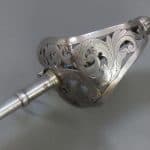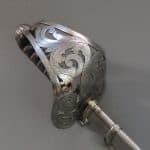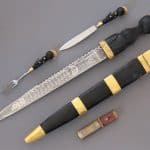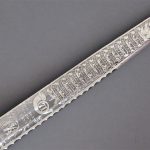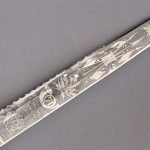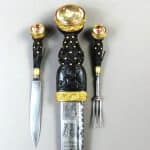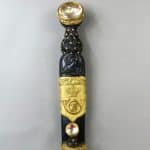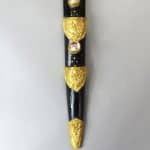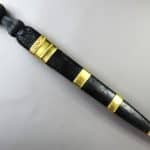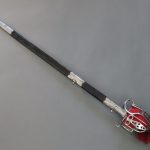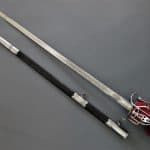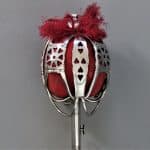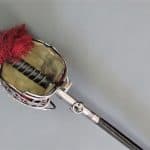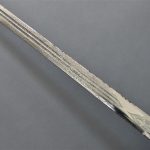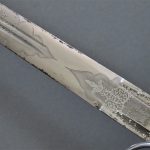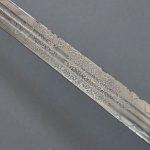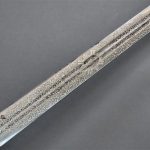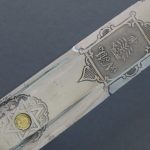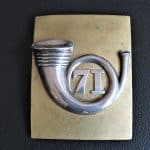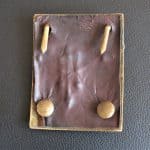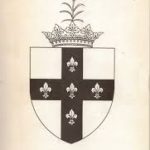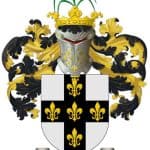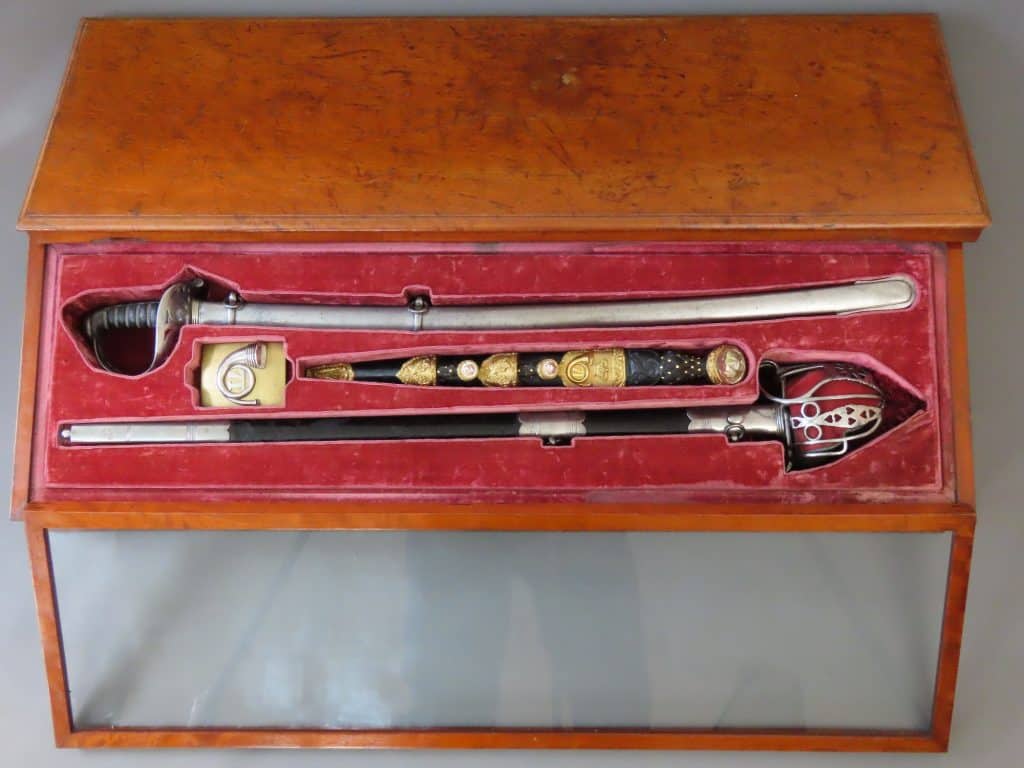
An exceptional cased suite of edged weapons of Lieutenant Wyndham Neave of the 71st Highland Light Infantry killed in action in 1858 in the Indian Mutiny
To enquire about this itemplease click here
Price: £15,000
Ref: AA.109.20
Item Description
Lieutenant Wyndham Neave of the 71st Highland Light Infantry was killed at Morar during the advance of the forces of Sir Hugh Rose against rebels at Gwalior in Central India on 16th June 1858 in the Indian Mutiny. This is his weapons set which was cased for display, probably in India, then returned to his family in England after his death. The weapons are a unique snapshot of an officer’s dress and field edged weapons of the time and are in exceptional condition. The case is a fine example of the cabinet maker’s craft.
Lt Neave was born on 21st November 1834, the 4th son of Sir Richard Digby Neave, 3rd Baronet (1793–1868), who was an English artist and author. Kaye & Malleson’s History of the Indian Mutiny 1857-8, describes the action in which Lt Neave was killed as follows:
“The main body of the enemy, driven through the cantonments, fell back on a dry nullah (a steep sided watercourse) with high banks, running round a village, which they had also occupied. Here they maintained a desperate hand-to-hand struggle with the British. The 71st Highlanders suffered severely, Lieutenant Neave, whilst leading them, falling mortally wounded; nor was it till the nullah was nearly choked with dead that the village was carried”.
In a more personal account Lieutenant John Lightfoot of the Bombay Horse Artillery described the action as follows in a letter to his father:
“Just at this time there came a cheer from the rear and up came the 71st at the double, I ceased firing and they rushed past straight at the nullah, the rebels did not wait for their approach but, throwing down their muskets they drew their swords and waving them over their heads, dashed forward to meet the 71st, young Neave son of Sir Digby Neave was killed at the first onset, but not a rebel escaped. They were killed to a man!’ Besides Lieutenant Neave, the 71st had four men killed and five men wounded, four of those severely”.
The set consists of Lt Neave’s dress basket hilted broadsword, his field service sword, dress dirk and shoulder belt plate, all notable for their excellent quality and fine condition. The set is contained in purpose built contemporary fitted mahogany case with two locks fitted to each side. When the top lid is lifted off a second glazed lid is revealed through which the items may be viewed. This can also be lifted off to access the items by hand which are seated in shaped hard lined apertures lined with plum coloured velvet.
The Scottish basket hilted broad sword is by Henry Wilkinson and not numbered. Henry Wilkinson began their numbering system in 1854 which dates the production of this sword to circa 1848-1854. The regulation pattern straight blade is 32.25 inches (82cm) long and profusely etched with fine designs. The pronounced ricasso has a deep fuller near to each blunt edge and further along the blade two central fullers run in parallel. Inside the ricasso on one side is “HENRY WILKINSON, PALL MALL, LONDON” and on the reverse side a star shaped cartouche with a brass stud inside stamped with “HW” for Henry Wilkinson in raised relief. Just beyond the ricasso on the same side is an ornate cartouche with the owners initials “WN” and crest.
Further along on the same side is an elaborate foliate panel which contains the regimental emblem and the numerals “LXXI” for “71”. On the reverse side a similar foliate panel contains the “VR” cypher with a crown above. The regulation basket guard is pierced with hearts and circles, mounted with a fluted bun-shaped pommel with button, wooden spirally grooved grip covered with black shagreen bound with silver wire, and retaining its red fringe and scarlet cloth faced buff leather liner with blue silken hem. The sword retains its polished finish. The sword is contained in its black leather scabbard with three matching steel mounts with linear engraving, the top locket with suspension ring and frog stud and middle mount with suspension ring. The sword is in fine condition with a few insignificant age related blemishes.
The field service sword is also by Henry Wilkinson punched with the number 6596 for 1855. The slightly curved fullered blade is 32.25 inches (82 cm) long and contained in its steel scabbard also punched with the same number. The forte is marked same as the basket hilted sword with “HENRY WILKINSON, PALL MALL, LONDON” and with a star and brass roundel punched with HW in raised relief on the reverse side. On one side within a panel of etched thistles is the “VR” cypher with crown above and “HIGHLAND” with a bugle below with the number “71” inside its loop then “LT INFANTRY” below. On the reverse side between panels of thistles the battle honours of the regiment are detailed within a scroll design beginning with “PENINSULA” and “WATERLOO” then ending with “HINDOOSTAN”. The blade retains its polished finish.
The steel hilt is mounted with a scrolled wrist guard and typically pierced with foliate designs and engraved with leaf-like scrolls. The pommel is domed and cut with radiating flutes. The wooden grip is covered with black shagreen, and bound with silver wire.
The dress dirk is exceptional and of robust size mounted with ebony grip and deeply chased Ormolu mounts. The leaf shaped blade measures just over 13 inches (just over 33 cm) and the dirk 19 inches overall length (just over 48 cm). It measures just under 20.5 inches (52 cm) when measured end to end in its scabbard. The baluster shaped dirk grip is cut with a Scottish military bonnet and crossed swords between the haunches to the front and with a thistle on the reverse in raised relief. The middle section is cut with a decorative basket weave pattern highlighted with gilt brass studs at the intersections at the front and with ridges of longitudinal lines to the rear which extend upwards to the back of the canted pommel. The pommel band and mouthpiece are of cast brass with a flowing band of thistles and leaves in raised relief.
The grips of the knife and fork are cut with basket weave all over with studs at the intersections. The pommels are canted and the bands are of similar form to the dirk. At the base of the knife and fork grips a tapering ferrule holds in place a blued clip of sprung steel which holds in place each item when sheathed. The dirk, knife and fork are mounted with pommel stones cut in a multi-faceted manner around the edges with flat tops and a slight rose pink hue in background colour. The black patent leather scabbard mouthpiece is mounted with a bugle with “71” inside the loop and a crown above. The front of the knife mouthpiece, the fork mouthpiece, and the chape are mounted with thistles in raised relief.
The blade is scalloped along its back edge for over half its length after which it is double edged. A deep fuller runs underneath this part of the blade for the same length, and underneath this a wider, shallower fuller extends for the same length along each side.
Viewed from the hilt towards the tip on one side, the blade is etched with a panel of bordered interlace above which in floral script are the letters “HLI” for the Highland Light Infantry. Above this the regimental motto “NEMO ME IMPUNE LACASSET” is clear. The next etched design is a bugle with “71” inside its loop with a thistle above, followed by a stand of arms, and a further thistle beyond.
On the reverse side the first panel contains the name of the retailer / maker “JONES, 6 REGENT ST, LONDON” with the “VR” cypher above in the same script as the “HLI” script on the first side. Above this, where the motto is place on the first side is “HIGHLAND LIGHT INFANTRY” with the bugle and “71” inside its loop. Along the rest of the blade the battle honours also represented on the field service sword are repeated in a panel beginning with “WATERLOO” and ending with “HINDOOSTAN” with a thistle above. The dirk is in fine condition retaining almost all of its original finish and exhibiting almost no wear. The dirk retains its braid suspension strap.
A shoulder-belt plate for an officer of the 71st is also accommodated in the case. This has a copper-gilt stippled ground with the silver applied regimental device of “71” within a bugle loop. It retains its hook, stud fittings on the reverse and its original leather backing.











